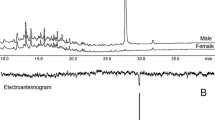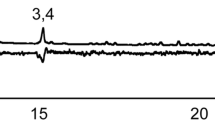Abstract
The 7–8th ventral abdominal gland secretions from 6 adult male leaf-footed bugs,Leptoglossus spp., and a related species,Euthochtha galeator, were chemically analyzed by GC-MS. Of the 11 volatile compounds identified, all but one of the compounds (n-octanol) were aromatic, including compounds with the familiar odors of cherries, vanilla, cinnamon, and roses. The preponderance of aromatics in the adult male ventral abdominal gland secretions contrasts sharply with the aliphatic compounds which comprise the metathoracic gland defensive secretions of adult males and females. Also, the male-specific secretions are species-specific, both qualitatively and quantitatively, whereas the metathoracic gland secretions of Coreoidea are only distinctive at the generic level. It is proposed that males were favored as the emitters of attractive signals by sexual selection, whereas the specificity of the signal is the result of natural selection against hybridization.
Similar content being viewed by others
References
Aldrich, J.R., andYonke, T.R. 1975. Natural products of abdominal and metathoracic scent glands of coreoid bugs.Ann. Entomol. Soc. Am. 68:955–960.
Aldrich, J.R., Blum, M.S., Duffy, S.S., andFales, H.M. 1976. Male specific natural products in the bug,Leptoglossus phyllopus: Chemistry and possible function.J. Insect Physiol. 22:1201–1206.
Aldrich, J.R., Blum, M.S., Lloyd, H.A., andFales, H.M. 1978a. Pentatomid natural products: Chemistry and morphology of the III-IV dorsal abdominal glands of adults.J. Chem. Ecol. 4:161–175.
Aldrich, J.R., Blum, M.S., Hefetz, A., Fales, H.M., Lloyd, H.A., andRoller, P. 1978b. Proteins in a nonvenomous defensive secretion: Biosynthetic significance.Science 201:452–454.
Allen, R.C. 1969. A revision of the genusLeptoglossus Guerin (Hemiptera: Coreidae).Entomol. Am. 45:35–140.
Baker, J.T., andKemball, P.A. 1967. Volatile constituents of the scent gland reservoir of the coreid,Pternistria bispina Stal.Aust. J. Chem. 20:395–398.
Baker, J.T., Blake, J.D., MacLeod, J.K., Ironside, D.A., andJohnson, I.C. 1972. The volatile constituents of the scent gland reservoir of the fruit-spotting bug,Amblypelta nitida.Aust. J. Chem. 25:393–400.
Brennan, B.M., Chang, F., andMitchell, W.C. 1977. Physiological effects of sex pheromone communication in the southern green stink bug,Nezara viridula.Environ. Entomol. 6:169–173.
Cade, W. 1975. Acoustically orienting parasitoids: Fly phonotaxis to cricket song.Science 190:1312–1313.
Cade, W. 1978. The evolution of alternative male reproductive strategies in field crickets,in M.S. Blum and N.A. Blum (eds.). Reproductive Competition and Selection in Insects Academic Press, New York. In press.
Dingle, H. 1972. Migration strategies of insects.Science 175:1327–1335.
Games, D.E., andStaddon, B.W. 1973. Chemical expression of a sexual dimorphism in the tubular scent glands of the milkweed bugOncopeltus fasciatus (Dallas) (Heteroptera: Lygaeidae).Experientia 29:532–533.
Ghiselin, M.T. 1974. The Economy of Nature and the Evolution of Sex. University of California Press, Berkeley.
Gibly, A.R., andWaterhouse, D.F. 1967. Secretions from the lateral scent glands of the green vegetable bug,Nezara viridula.Nature 216:90–91.
Harris, V.E.,Todd, J.W. 1978. Aggregation of male and female southern green stink bug,Nezara viridula, and attraction of its parasitoid,Trichopoda pennipes, as a response to maleN. viridula pheromone.Environ. Entomol., in press.
Heller, S.R. 1972. Conversational mass spectral retrieval system and its use as an aid in structure determination.Anal. Chem. 44:1951–1961.
Mayr, E. 1972. Sexual selection and natural selection, pp. 1871–1971,in B. Campbell (ed.). Sexual Selection and the Descent of Man. Aldine, Chicago.
McCullough, T. 1970. Acid content of scent fluid fromAcanthocephala femorata, A. declivis, andA. granulose (Hemiptera, Coreidae).Ann. Entomol. Soc. Am. 63:1199–1200.
McCullough, T. 1971. Chemical analysis of the defensive scent fluid released byHypselonotus punctiventris (Hemiptera: Coreidae).Ann. Entomol. Soc. Am. 64:749.
McCullough, T. 1973. Chemical analysis of the defensive scent fluid from the bugMozena obtusa (Hemiptera: Coreidae).Ann. Entomol. Soc. Am. 66:231–232.
McCullough, T. 1974a. Chemical analysis of the defensive scent fluid produced byMozena lunata (Hemiptera: Coreidae).Ann. Entomol. Soc. Am. 67:298.
McCullough, T. 1974b. Chemical analysis of the defensive scent fluid from the cactus bugChelinidea vittiger.Ann. Entomol. Soc. Am. 67:300.
Mitchell, W.C., andMau, R. F. L. 1971. Response of the female southern green stink bug and its parasite,Trichopoda pennipes to male stink bug pheromones.J. Econ. Entomol. 64:856–859.
Moore, B.P., andWallbank, B.E. 1968. Chemical composition of the defensive secretion in carabid beetles and its importance as a taxonomic character.Proc. R. Entomol. Soc. London (B) 37:62–72.
Rothschild, M. 1961. Defensive odours and Mullerian mimicry among insects.Trans. R. Entomol. Soc. London 113:101–109.
Stenhagen, W.S., Abrahamsson, S., andMcLafferty, F.W. 1969. Atlas of Mass Spectral Data, pp. 1–3. Wiley, New York.
Todd, J.W., andLewis, W.J. 1976. Incidence and ovisposition patterns ofTrichopoda pennipes (F.), a parasite of the southern green stink bug,Nezara viridula (L.).J. Entomol. Soc. 11:50–54.
Tschinkel, W.R. 1975. A comparative study of the chemical defensive system of tenebrionid beetles: Chemistry of the secretions.J. Insect Physiol. 21:753–783.
Tsuyuki, T., Ogata, Y., Yamamoto, I., andShimi, K. 1965. Stink bug aldehydes.Agric. Biol. Chem. 29:419–427.
Ubik, K., Vrkoc, J., Zdarek, J., andKontev, C. 1975. Vanillin: A possible sex pheromone of an insect.Naturwissenschaften 62:348.
Vrkoc, J., Ubik, K., Zdárek, J., andKontev, C. 1977. Ethyl acrylate and vanillin as components of the male sex pheromone complex inEurygaster integriceps (Heteroptera, Scutelleridae).Acta Entomol. Bohemoslov. 74:205–206.
Wallbank, B.E., andWaterhouse, D.F. 1970. The defensive secretions ofPolyzosteria and related cockroaches.J. Insect Physiol. 16:2081–2096.
Waterhouse, D.F., andGibly, A.R. 1964. The adult scent glands and scent of nine bugs of the superfamily Coreoidea.J. Insect Physiol. 10:977–987.
Author information
Authors and Affiliations
Rights and permissions
About this article
Cite this article
Aldrich, J.R., Blum, M.S. & Fales, H.M. Species-specific natural products of adult male leaf-footed bugs (Hemiptera: Heteroptera). J Chem Ecol 5, 53–62 (1979). https://doi.org/10.1007/BF00987687
Received:
Revised:
Issue Date:
DOI: https://doi.org/10.1007/BF00987687




